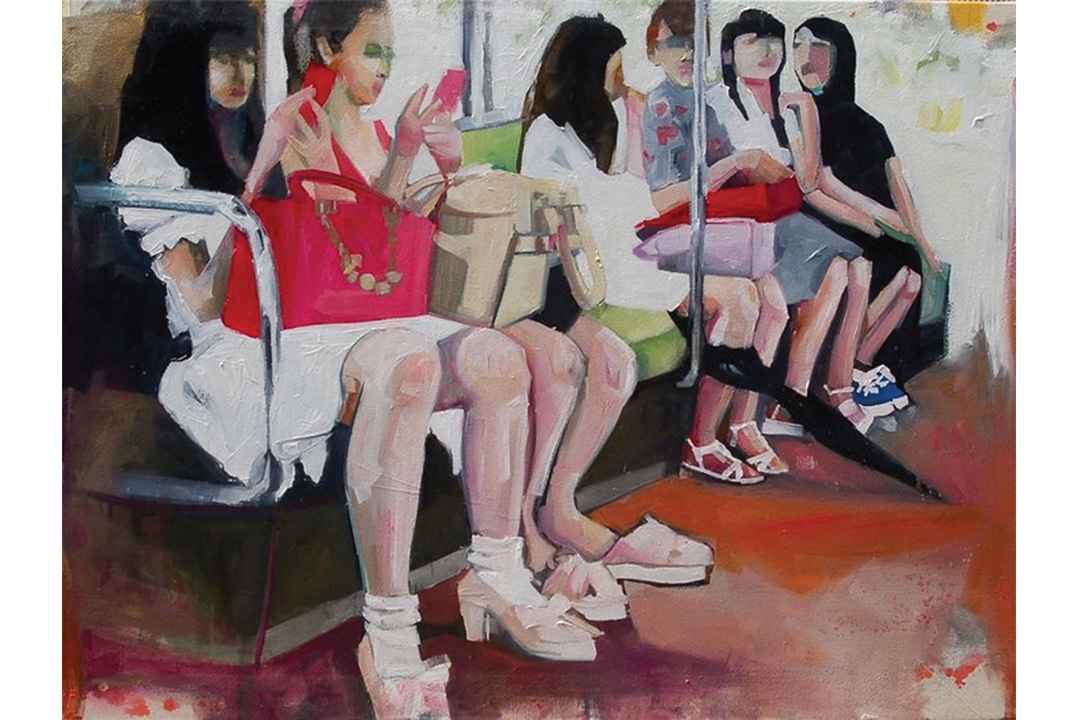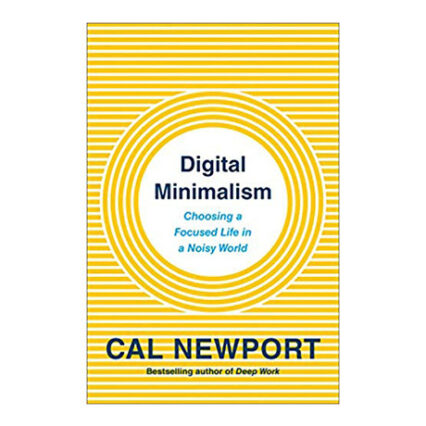7 Tales of Digital Minimalism
Pretty in Pink by Ruth Shively
What we all need is a philosophy of technology use, something that covers from the ground up which digital tools we allow into our life, for what reasons, and under what constraints.
Around the time I started working on this piece, a columnist for the New York Post published an op‑ed titled “How I Kicked the Smartphone Addiction—and You Can Too.” His secret? He disabled notifications for 112 different apps on his iPhone. “It’s relatively easy to retake control,” he optimistically concludes.
These types of articles are common in the world of technology journalism. The author discovers that his relationship with his digital tools has become dysfunctional. Alarmed, he deploys a clever life hack, then reports enthusiastically that things seem much better. I’m always skeptical about these quick‑fix tales. In my experience covering these topics, it’s hard to permanently reform your digital life by using tips and tricks alone.
The problem is that small changes are not enough to solve our big issues with new technologies. The underlying behaviors we hope to fix are ingrained in our culture, and they’re backed by powerful psychological forces that empower our base instincts. To reestablish control, we need to move beyond tweaks and instead rebuild our relationship with technology from scratch, using our deeply held values as a foundation.
The New York Post columnist cited above, in other words, should look beyond the notification settings on his 112 apps and ask the more important question of why he uses so many apps in the first place. What he needs—what all of us who struggle with these issues need—is a philosophy of technology use, something that covers from the ground up which digital tools we allow into our life, for what reasons, and under what constraints. In the absence of this introspection, we’ll be left struggling in a whirlwind of addictive and appealing cyber‑trinkets, vainly hoping that the right mix of ad hoc hacks will save us.
I have one such philosophy to propose:
Digital Minimalism
A philosophy of technology use in which you focus your online time on a small number of carefully selected and optimized activities that strongly support things you value, and then you happily miss out on everything else.
The so‑called digital minimalists who follow this philosophy constantly perform implicit cost‑benefit analyses. If a new technology offers little more than a minor diversion or trivial convenience, the minimalist will ignore it. Even when a new technology promises to support something the minimalist values, it must still pass a stricter test: Is this the best way to use technology to support this value? If the answer is no, the minimalist will set to work trying to optimize the tech, or else search out a better option.
By working backward from their deep values to their technology choices, digital minimalists transform these innovations from a source of distraction into tools to support a life well lived. By doing so, they break the spell that has made so many people feel like they’re losing control to their screens.
If a new technology offers little more than a minor diversion or trivial convenience, the minimalist will ignore it.
Notice, this minimalist philosophy contrasts starkly with the maximalist philosophy that most people deploy by default—a mindset in which any potential for benefit is enough to start using a technology that catches your attention. A maximalist is very uncomfortable with the idea that anyone might miss out on something that’s the least bit interesting or valuable. Indeed, when I first started writing publicly about the fact that I’ve never used Facebook, people in my professional circles were aghast for exactly this reason. “Why do I need to use Facebook?” I would ask. “I can’t tell you exactly,” they would reply, “but what if there’s something useful to you in there that you’re missing?”
This argument sounds absurd to digital minimalists, because they believe that the best digital life is formed by carefully curating their tools to deliver massive and unambiguous benefits. They tend to be incredibly wary of low‑value activities that can clutter up their time and attention and end up hurting more than they help. Put another way: Minimalists don’t mind missing out on small things; what worries them much more is diminishing the large things they already know for sure make a good life good.
To make these abstract ideas more concrete, let’s consider seven real‑world examples of digital minimalists I uncovered in my research on this emerging philosophy. For some of these minimalists, the requirement that a new technology strongly supports deep values led to the rejection of services and tools that our culture commonly believes to be mandatory.

Young Girls on Train by Ruth Shively
1. Tyler
Tyler originally joined the standard social media services for the standard reasons: to help his career, to keep him connected, and to provide entertainment. Once Tyler embraced digital minimalism, however, he realized that although he valued all three of these goals, his compulsive use of social networks offered at best minor benefits, and it did not qualify as the best way to use technology for these purposes. So he quit all social media to pursue more direct and effective ways to help his career, connect with other people, and be entertained.
I met Tyler roughly a year after his minimalist decision to leave social media. He was clearly excited by how his life had changed during this period. He started volunteering near his home, he exercises regularly, he’s reading three to four books a month, he began to learn to play the ukulele, and he told me that now that his phone is no longer glued to his hand, he’s closer than he has ever been with his wife and kids. On the professional side, the increased focus he achieved after leaving these services earned him a promotion. “Some of my work clients have noticed a change in me and they will ask what I am doing differently,” he told me. “When I tell them I quit social media, their response is ‘I wish I could do that, but I just can’t.’ The reality, however, is that they literally have no good reason to be on social media!”
As Tyler is quick to admit, he can’t completely attribute all these good things to his specific decision to quit social media. It was a symbolic gesture that reinforced his new commitment to the minimalist philosophy of working backward from your deeply held values when deciding how to live your life.
2. Adam
Adam runs a small business, and the ability to remain connected to his employees is important for his livelihood. Recently, however, he became worried about the example he was setting for his nine‑ and 13‑year‑old kids. He could talk to them about the importance of experiencing life beyond a glowing screen, he realized, but the message wouldn’t stick until they saw him demonstrating this behavior in his own life. So, he did something radical: he got rid of his smartphone and replaced it with a basic flip phone.
“I have never had a better teachable moment in my life,” he told me about his decision. “My kids know my business depends on a smart device and saw how much I used it, and here I was giving it up?! I was able to clearly explain why, and they got it!”
As Adam admits, the loss of his smartphone made certain things in his work life more annoying. In particular, he relies heavily on text messages to coordinate with his staff, and he soon relearned how hard it is to type on the little plastic buttons of an old‑fashioned cell phone. But Adam is a digital minimalist, which means maximizing convenience is prioritized much lower than using technology to support his values. As a father, teaching his kids an important lesson about embracing life beyond the screen was far more important than faster typing.
3 Principles of Digital Minimalism
Principle #1: Clutter is costly.
Digital minimalists recognize that cluttering their time and attention with too many devices, apps, and services creates an overall negative cost that can swamp the small benefits that each individual item provides in isolation.
Principle #2: Optimization is important.
Digital minimalists believe that deciding that a particular technology supports something they value is only the first step. To truly extract its full potential benefit, it’s necessary to think carefully about how they’ll use the technology.
Principle #3: Intentionality is satisfying.
Digital minimalists derive significant satisfaction from their general commitment to being more intentional about how they engage with new technologies. This source of satisfaction is independent of the specific decisions they make and is one of the biggest reasons that minimalism tends to be immensely meaningful to its practitioners.
3. Michal
Michal decided her obsession with online media was causing more harm than good. In response, she restricted her digital information intake to a pair of email newsletter subscriptions and a handful of blogs that she checks “less than once a week.” She told me that these carefully selected feeds still satisfy her craving for stimulating ideas and information without dominating her time and toying with her mood.
4. Charles
Charles told me he had been a Twitter addict before adopting Digital Minimalism. He has since quit that service and instead receives his news through a curated collection of online magazines that he checks once a day in the afternoon. He told me that he’s better informed than he was during his Twitter days while also now thankfully freed of the addictive checking and refreshing that Twitter encourages in its users.
5. Carina
Carina is on the executive council of a student organization that uses a Facebook group to coordinate its activities. To prevent this service from exploiting her attention every time she logs on for council business, she reduced her set of friends down to only the 14 other people on the executive council and then unfollowed them. This preserves her ability to coordinate on the Facebook group while at the same time keeping her newsfeed empty.

More Girls Shopping in Japan by Ruth Shively
6. Blair
Blair bookmarked the Facebook events page so she could check on upcoming community events while bypassing “[all the] junk that Facebook is made up of.” Blair told me that keeping up with local events through this bookmarked page takes about five minutes, once or twice a week. The average Facebook user, by contrast, uses the company’s products a little over 50 minutes per day.
7. Dave
Dave reduced his persistent social media use down to only a single service, Instagram, which he felt offered significant benefits to his deep interest in art. In true minimalist fashion, however, Dave didn’t settle for simply deciding to “use” Instagram; instead, he thought hard about how best to integrate this tool into his life. In the end, he settled on posting one picture every week of whatever personal art project he happens to be working on. “It’s a great way for me to have a visual archive of my projects,” he explained. He also follows only a small number of accounts, all of which belong to artists whose work inspires him—making the experience of checking his feed both fast and meaningful.
As Dave explained to me, his own father wrote him a handwritten note every week during his freshman year of college. Still touched by this gesture, Dave began a habit of drawing a new picture every night to place in his oldest daughter’s lunchbox. His two youngest children watched this ritual with interest. When they became old enough for lunchboxes, they were excited to start receiving their daily drawings as well. “Fast‑forward a couple of years, and I’m spending a decent chunk of time every night doing three drawings!” Dave told me with obvious pride. “This wouldn’t have been possible if I didn’t protect how I spend my time.”

From Digital Minimalism by Cal Newport, published in February 2019 by Portfolio, an imprint of Penguin Publishing Group, a division of Penguin Random House, LLC. Copyright 2019 by Calvin C. Newport.


